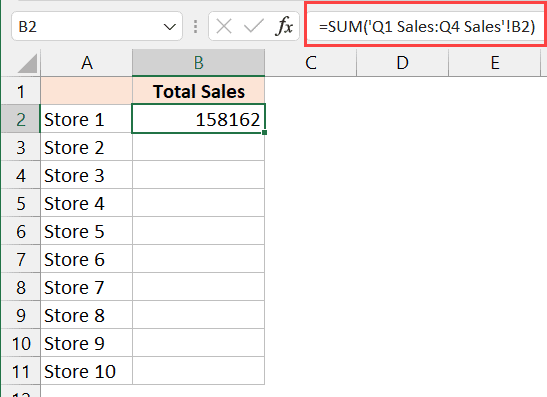Effortlessly Sum Data Across Multiple Excel Sheets

In the fast-paced realm of data management, Excel remains an unchallenged titan, offering a variety of tools that streamline your analytical tasks. One of its most powerful features is the ability to sum data across multiple sheets. This article will dive deep into this functionality, guiding you through the nuances of aggregating data from numerous Excel sheets. Whether you're a financial analyst looking to compile quarterly reports, an HR manager organizing staff payroll, or simply an Excel enthusiast, mastering this technique is bound to save time and enhance productivity.
Understanding the Basics of Excel Workbooks and Worksheets

Before we delve into summing data across sheets, it's crucial to grasp the foundational structure of Excel:
- A Workbook is the whole file, containing multiple sheets or worksheets where data is organized.
- Worksheets are individual pages within the workbook where you can work on data independently or link data between sheets.
This distinction is essential as it directly influences how we interact with and manipulate data across sheets.
The Power of Functions in Excel

Excel functions are the backbone of data analysis. Here are some key functions we'll be using to sum data across sheets:
- 3D References: A way to reference the same cell or range across multiple sheets.
- SUMIF and SUMIFS: Functions to sum based on specific criteria.
- Get and Transform (Power Query): A more advanced tool for large datasets.
3D References for Summing Data

3D references allow you to perform calculations across multiple worksheets. Here's how to use them:
- Select the cell where you want the sum to appear.
- Type
=SUM(, followed by the range of sheets in the workbook from which you want to sum. For example: - Press Enter.
=SUM(Sheet1:Sheet3!A1)
💡 Note: Ensure the sheet names are correctly spelled and in the proper sequence. If sheets are named sequentially, use the colon for shorthand: Sheet1:Sheet3. If not, list each sheet individually separated by commas.
Advanced Summing with SUMIF and SUMIFS

SUMIF and SUMIFS allow you to sum data based on one or multiple conditions. Here's how you can utilize these functions:
- SUMIF: Use when you need to sum cells that meet a single criterion.
- SUMIFS: Use for summing cells that meet multiple criteria.
For example, to sum all values in range A1:A10 across multiple sheets where cell B1 equals "Product A":
=SUMIF(Sheet1:Sheet3!B1, "Product A", Sheet1:Sheet3!A1:A10)
Using Excel's Get & Transform Feature (Power Query)

When working with extensive datasets across numerous sheets, Get and Transform can be a game-changer:
- Go to the Data tab, click Get Data, then select From Other Sources.
- Choose From Microsoft Query, then select Excel Files and specify your Excel workbook.
- Navigate through the tables representing each worksheet, select the ones you need, and choose your linking key.
- Use the Append Queries tool to combine tables vertically or Merge Queries for side-by-side consolidation.
- Load the combined data into a new sheet and use Excel functions to sum the data as required.
Troubleshooting and Best Practices

When working with Excel, errors are common, especially when dealing with multiple sheets:
- Check for Typos: Sheet names and cell references must be accurate.
- Worksheet Protection: Ensure no sheets are protected, as this can prevent formulas from updating.
- Ensure Consistent Ranges: Ranges must be identical across sheets for 3D references to work correctly.
- Use Named Ranges: This can make your formulas easier to understand and maintain.
- Organize Sheets Logically: Group related sheets together to simplify data management.
Harnessing Automation for Efficiency

Automation can significantly enhance your workflow when dealing with large datasets:
- VBA (Visual Basic for Applications): Scripts can automate repetitive tasks, including summing data across sheets.
- Macros: Macros can record a sequence of tasks and apply them across multiple sheets.
- Power Query: Automate data transformation and combination processes.
🛑 Note: While automation can boost efficiency, always ensure your scripts or macros don't inadvertently introduce errors into your dataset.
To wrap up, we've journeyed through the vast capabilities of Excel in summing data across multiple sheets. From the fundamental 3D references to the intricate possibilities of functions like SUMIF, SUMIFS, and Power Query, this guide has equipped you with the tools to tackle your data aggregation needs. Remember, mastering Excel isn't just about knowing the functions, but understanding when and how to apply them for optimal results. Keep practicing, stay updated with the latest Excel features, and let data management become a seamless part of your work.
Can I sum cells across sheets with different column formats?

+
Yes, you can sum cells across sheets with different column formats, but you must ensure the cells you’re summing are consistent in placement across sheets. Functions like SUMIF and SUMIFS can handle different column names or formats if you use consistent criteria.
How do I sum only visible cells across sheets?

+
Summing only visible cells across sheets requires a workaround since Excel’s native functions like SUBTOTAL can’t sum across sheets directly. You could use VBA to loop through visible cells or apply filters to hide unwanted data and use standard summing functions on visible ranges.
Is there a limit to the number of sheets I can reference in a 3D formula?

+
Excel has a limit on the total number of cells in a workbook, not on the sheets per se. However, practical limitations often arise due to hardware constraints or formula length. For large datasets, Power Query or VBA might be more efficient.
What if my sheet names have spaces or special characters?

+
Use single quotes around the sheet names in formulas. For example, ‘=SUM(‘Sheet Name 1’!A1:Sheet2!A1)‘.
How can I ensure my formulas update automatically when I add or remove sheets?

+
If you’re using a named range or a dynamic 3D reference (e.g., =‘Sheet1:’ & ‘NewSheet’!A1), Excel will adjust automatically. Otherwise, you’ll need to update the references manually or use VBA to automate this process.



